|
|
|
Sort Order |
|
|
|
Items / Page
|
|
|
|
|
|
|
| Srl | Item |
| 1 |
ID:
126873


|
|
|
|
|
| Publication |
2011.
|
| Summary/Abstract |
The article presents the author's views concerning the political issue over the archaeological excavations and studies in Jerusalem. The author cites the decision of the city government to demolish 22 Palestinian dwellings in Silwan in order to construct the "Garden of the King" archaeological park. The author denotes how archaeology can mend the Israeli-Palestinian conflicts. The archaeology's implication on culture is also noted.
|
|
|
|
|
|
|
|
|
|
|
|
|
|
|
|
| 2 |
ID:
131518
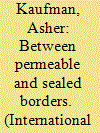

|
|
|
|
|
| Publication |
2014.
|
| Summary/Abstract |
The Trans-Arabian Pipeline (Tapline), which extended from Dhahran in Saudi Arabia to Zahrani in Lebanon and operated from 1950 to 1982, was haunted by the Arab-Israeli conflict throughout the years of its operation. The route of the pipeline-which traversed Saudi Arabia, Jordan, Syria, and Lebanon-was chosen so as to circumvent Palestine/Israel. However, following the Israeli occupation of the Golan Heights in the 1967 war, Israel became an active participant in this project, with the full consent of the transit states and Egypt. This article uses Tapline as a means to analyze the interconnected world facilitated by oil pipelines, which defies common wisdom about state sovereignty or the function of interstate boundaries. In addition, Tapline demonstrates how this interconnected network created possibilities for Arab-Israeli cooperation that might have seemed inconceivable initially, given the hostile dynamics of the conflict.
|
|
|
|
|
|
|
|
|
|
|
|
|
|
|
|
| 3 |
ID:
106462
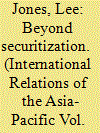

|
|
|
|
|
| Publication |
2011.
|
| Summary/Abstract |
Since the late 1980s, the scope of security policy has widened dramatically to encompass a wide range of 'non-traditional' threats. Southeast Asian states have superficially appeared to embrace this trend, broadening their security discourse considerably. However, they are also often criticized for failing to translate this discursive shift into concrete regional cooperation to tackle these new threats. This article critiques the dominant theoretical framework used to explore the widening of states' security agendas - the Copenhagen School's 'securitization' approach - as unable to account for this gap due to its fixation on security discourse rather than practice. Drawing on state theory and insights from critical political economy, the article argues that the scope of regional security policy is better accounted for by the distinctive nature of state-society relations within Southeast Asia. The argument is advanced using case studies of Southeast Asian states' policies toward Burma, environmental degradation, and border conflicts.
|
|
|
|
|
|
|
|
|
|
|
|
|
|
|
|
| 4 |
ID:
131026
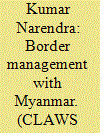

|
|
|
|
|
| Publication |
2014.
|
| Summary/Abstract |
Neighbouring states are most relevant in foreign policy' and Myanmar, indeed, has strategic, economic, cultural and religious signi?cance for India. Myanmar is not where only China and India 'meet'; it is also the intersection between South Asia and Southeast Asiaz. It is a gateway to South Asia and a land bridge to the Association for Southeast Asian Nations (ASEAN). It is an opportunity and also brings with it a certain amount of vulnerabilities as well. Myanmar has huge potential for meeting India's energy requirement and for markets for Indian consumer goods; in return, India can contribute immensely in the field of infrastructure development, communication, education, tourism industry, science and technology. India and Myanmar are historically linked to each other through religion, people-to-people contact and sharing ethnically identical populations on both sides of the borders. The porous land borders of India and Myanmar are a cause of concern for peace, stability and economic development. Inhospitable terrain and an underdeveloped border region provide an ideal platform for insurgents, non-state actors, drugs and weapons traffickers to operate and spread their network
|
|
|
|
|
|
|
|
|
|
|
|
|
|
|
|
| 5 |
ID:
133502
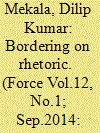

|
|
|
|
|
| Publication |
2014.
|
| Summary/Abstract |
At a time when incidents at the Indo-Pakistan border make it to the headlines every day, there is hardly any reportage on the other important border, the Indo-Bangladesh border. The recent director general level talks between Border Security Force (BSF) and Border Guard Bangladesh (BGB) was one such event which didn't find much mention in the newspapers. The Delhi edition of this biannual event saw the participation of delegations from both sides and issues related to effective border management were discussed.
|
|
|
|
|
|
|
|
|
|
|
|
|
|
|
|
| 6 |
ID:
138241
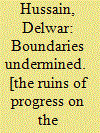

|
|
|
|
|
| Publication |
New Delhi, Oxford University Press, 2013.
|
| Description |
xvii, 187p.Hbk
|
| Standard Number |
9780199459407
|
|
|
|
|
|
|
|
|
|
|
|
Copies: C:1/I:0,R:0,Q:0
Circulation
| Accession# | Call# | Current Location | Status | Policy | Location |
| 058200 | 320.125492054/HUS 058200 | Main | On Shelf | General | |
|
|
|
|
| 7 |
ID:
126975
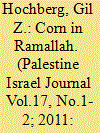

|
|
|
|
|
| Publication |
2011.
|
| Summary/Abstract |
A personal narrative is presented which explores the author's experience of having a short visit to Israel, A contemporary tale of two Israeli citizens whose friendly visit to Ramallah becomes one of Israel's latest successful rescue operations
|
|
|
|
|
|
|
|
|
|
|
|
|
|
|
|
| 8 |
ID:
127787
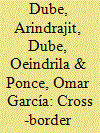

|
|
|
|
|
| Publication |
2013.
|
| Summary/Abstract |
To what extent, and under what conditions, does access to arms fuel violent crime? To answer this question, we exploit a unique natural experiment: the 2004 expiration of the U.S. Federal Assault Weapons Ban exerted a spillover on gun supply in Mexican municipios near Texas, Arizona, and New Mexico, but not near California, which retained a pre-existing state-level ban. We find first that Mexican municipios located closer to the non-California border states experienced differential increases in homicides, gun-related homicides, and crime gun seizures after 2004. Second, the magnitude of this effect is contingent on political factors related to Mexico's democratic transition. Killings increased disproportionately in municipios where local elections had become more competitive prior to 2004, with the largest differentials emerging in high narco-trafficking areas. Our findings suggest that competition undermined informal agreements between drug cartels and entrenched local governments, highlighting the role of political conditions in mediating the gun-crime relationship.
|
|
|
|
|
|
|
|
|
|
|
|
|
|
|
|
| 9 |
ID:
131564


|
|
|
|
|
| Publication |
2014.
|
| Summary/Abstract |
This article reads Bashar al-Asad's rule through the prism of social activism and, in particular, through the field of charities. The sociopolitical transformations Syria experienced between 2000 and 2010-the shift in state-society relations, the opening of the civic arena, and economic liberalization-are explored through the activities of charitable associations, including their interactions with other Syrian actors, and we argue that they reflect the unraveling of the old social contract. The Syrian leadership outsourced important state welfare functions to charities while also creating nongovernmental organizations (NGOs) under its own control and supporting developmental NGOs loyal to the regime. These NGOs differed from the existing charities in terms of their social base, financial backgrounds, motivations, modes of institutionalization, and public relations strategies, and enabled the authoritarian regime to pursue a new strategy of divide-and-rule politics. At the same time, subcontracting poor-relief measures to charities eroded the regime's political legitimacy and helped sow the seeds of the 2011 uprising.
|
|
|
|
|
|
|
|
|
|
|
|
|
|
|
|
| 10 |
ID:
132260
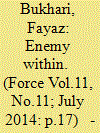

|
|
|
|
|
| Publication |
2014.
|
| Summary/Abstract |
This year the Indian Army achieved a major success by killing 41 militants including 11 top commanders of Lashkar-e-Toiba (LeT), Jaish-e-Mohammad (JeM) and Hizbul Mujahideen (HM) and arrested 23 of them in joint operations with the police.
The figures reveal that this is more than the number of militants neutralised last year, but over the years killing of militants is not making much of a difference as new recruits replace them.
Lieutenant General Subrata Saha, who took over as the General Officer Commanding (GOC) of Army's strategic Chinar Corps or 15 Corps, responsible for tackling militancy in Kashmir besides guarding the Line of Control (LC), has a bigger challenge ahead. For him, killing the militancy is a challenge and not counting the dead.
As per the figures given by the Jammu and Kashmir Police, there are 130 active militants in Kashmir valley and if the rate at which they were eliminated this year continues, not a single militant will be left by next year.
Says a senior army officer: "That is not the case, as per our records at least 16 Kashmiri youth, mostly educated, joined militancy this year. The numbers could be more than our records. And on an average two-three youth get lured into militancy during the funeral of a militant commander."
|
|
|
|
|
|
|
|
|
|
|
|
|
|
|
|
| 11 |
ID:
132339
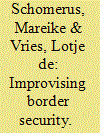

|
|
|
|
|
| Publication |
2014.
|
| Summary/Abstract |
This article compares two cases of securitization along South Sudan's border with the Democratic Republic of the Congo. By comparing how a security concern - the presence of the Lord's Resistance Army - was interpreted and responded to, the article shows that border security practices in two borderscapes are improvised, contradictory and contested, and serve to establish authority rather than actually securing the border. This is apparent on three levels: (a) through the multiplicity of security actors vying for authority; (b) in how they interpret security concerns; and (c) in terms of what practice follows. The article argues that by allowing authority at the border to be taken by actors that are not under direct control of the central government, the South Sudanese state is developing as one that controls parts of the country in absentia, either by granting discretionary powers to low-level government authorities at the border or through tactical neglect. Processes of securitization by both state and non-state actors in the borderland are largely disconnected from the South Sudanese central government, which does not claim authority over this border and thus seemingly does not consider the lack of security for its citizens, and the parallel authorities, as a threat to central stability.
|
|
|
|
|
|
|
|
|
|
|
|
|
|
|
|
| 12 |
ID:
130790
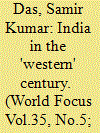

|
|
|
|
|
| Publication |
2014.
|
| Summary/Abstract |
In a paper written not quite long ago, I argued that the rise of Asia including in particular such powers as China, and India in recent decades takes places in a century that continues to remain western. As I concluded.
|
|
|
|
|
|
|
|
|
|
|
|
|
|
|
|
| 13 |
ID:
139872
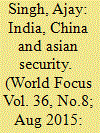

|
|
|
|
|
| Summary/Abstract |
The relationship between India and China is increasingly significant for Asia’s security dynamics and this vast continent, the home of half of humanity will be turbulent geopolitical space in 21st century. Differences among Asians around virtually at many level such as political, economic, social and cultural, yet there is a sense of Asian unity in terms of interdependence and a unified field of diplomatic and strategic action, in which the choices and concerns of Asian people are intertwined, both positively and negatively.
|
|
|
|
|
|
|
|
|
|
|
|
|
|
|
|
| 14 |
ID:
132335
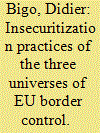

|
|
|
|
|
| Publication |
2014.
|
| Summary/Abstract |
What practices of (in)securitization involve the notions of border and border control in the European Union? How do these practices operate? How are they assembled? In the resulting assemblage, is the notion of borders - understood as state borders - still relevant for the control of individuals and populations moving across the frontiers of the EU? Drawing on empirical observations and with a specific focus on how border control is translated into different social universes, this article seeks to show that practices of control are routinely embedded in a practical sense that informs what controlling borders does and means. This practical sense is itself informed by different professional habitus and work routines involving deterrence and the use of force, interrogation and detention, surveillance of populations on the move and the profiling of (un)trusted travellers. Its strength varies in relation to its shared dimension by most of the operators, and is adjusted to the materiality of borders as well as to the local contexts in which it is deployed. It activates, or does not activate, the maximal use of various control technologies (satellites, pre-registration and interoperable exchange of data between the state and private bureaucracies, biometrics identifiers, body-scanners). For understanding practices of (in)securitization, actual work routines and the specific professional 'dispositions' are therefore more important than any discourses actors may use to justify their activities.
|
|
|
|
|
|
|
|
|
|
|
|
|
|
|
|
| 15 |
ID:
130889
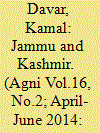

|
|
|
|
|
| Publication |
2014.
|
| Summary/Abstract |
The crown of India, the divinely beautiful and immensely strategic state of Jammu and Kashmir since its tumultuous accession to the Indian union in 1947, displayed at times, the pangs of an uneasy existence with the secular, liberal and generous environs of the parent nation. That is abiding emotional integration to Mother India, is still wanting in some spheres, even after 66 years of togetherness, is hardly a tribute to India's and the state's political leadership or governance notwithstanding the countless sacrifices made, monumental aid and resources invested for the security and development of India's restive northernmost state. That India's ever belligerent neighbor, Pakistan has left no stone unturned or any machination in the book to fan separatism in J&K which is considers its jugular vein is hardly surprising. In the globally troubled times of today, Pakistan and some others in the world forget that India is home to the third largest population in the world and thus J&K is not a mere symbol of India's secularism but its prime guarantee.
|
|
|
|
|
|
|
|
|
|
|
|
|
|
|
|
| 16 |
ID:
126884
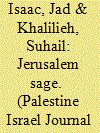

|
|
|
|
|
| Publication |
2011.
|
| Summary/Abstract |
In November 1947, the United Nations General Assembly adopted resolution 181, calling for the partition of Mandatory Palestine into two independent states - one for the Palestinian Arabs and one for the Jews - and for the designation of Jerusalem and its traditional link with Bethlehem as corpus separatum: a separate entity under special international protection to be administrated by an international body.
|
|
|
|
|
|
|
|
|
|
|
|
|
|
|
|
| 17 |
ID:
131046
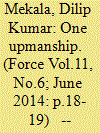

|
|
|
|
|
| Publication |
2014.
|
| Summary/Abstract |
Ever since the border face-off between Indian and Chinese Troops in the Depsang Bulge at the Line of Actual Control (LAC) in April 2013, the Indian Army has raised its pitch to acquire Operational Control of the Indo-Tibetan Border Police Force (ITBP). But that one incident couldn't have been the trigger, and it's not correct to dismiss ITBP's role in handling the situation. After all, the ITBP had followed all international protocols which ultimately led to the solution through diplomatic channels.
The Indian Army cannot be deployed along the forward posts at the LAC according to various UN conventions. So naturally when the Chinese troops entered the Indian territory close to the Burtse post in the Depsang Bulge, the ITBP was the first respondent. According to a source privy to the information, when the Chinese patrol team was observed coming close to the Burtse post, roughly around one-and-a-half or two kilometres away, the ITBP teams responded immediately. As per the Standard Operating Procedures (SOP), the ITBP has to inform all the stakeholders in events such as this. Sources claimed that the information was indeed relayed to all the stakeholders like National Security Advisor (NSA), defence ministry, Indian Army and various intelligence agencies in real time. The ITBP boasts of its quick communication to as many as 11 agencies involved in resolving the stand-off.
|
|
|
|
|
|
|
|
|
|
|
|
|
|
|
|
| 18 |
ID:
129882


|
|
|
|
|
| Publication |
2014.
|
| Summary/Abstract |
After the 1947 partition of India, the government of Afghanistan found an opportunity to reclaim the lands lost to British India as a result of the Durand Line agreement in 1983. These lands, known as Pashtinistan, were annexed to Pakistan. The issue of Pashtinistan's fate become the backbone of Afghanistan's foreign and domestic policies. This article explores the reasons for the Pashtunistan issue's significance to Afghanistan's royal family and how a policy of advancing Pashtun nationalism was conducted by the government, and what the issue meant for newly established political parties.
|
|
|
|
|
|
|
|
|
|
|
|
|
|
|
|
| 19 |
ID:
126214
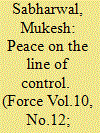

|
|
|
|
|
| Publication |
2013.
|
| Summary/Abstract |
The 778km long Line of Control (LC) from Akhnoor to NJ 9842 does not conform to easily recognisable terrain features in most sectors. The emphasis, therefore, is to hold areas physically and dominate them to establish a de facto proprietary right on ground, sometimes with scant regard to its tactical importance.
Strategically, the biggest security challenge is 'maintaining the sanctity of the LC'. Loss of territory is just not acceptable. This imposes a huge constraint in terms of deployment as well as measures to dominate inaccessible areas, especially in winter. Any intrusion on the LC has to be evicted on priority. The other important challenge is that of 'No Hot Pursuit'. This implies that any group of terrorists fleeing back to Pakistan or POK on interception cannot be pursued across the LC.
|
|
|
|
|
|
|
|
|
|
|
|
|
|
|
|
| 20 |
ID:
129255
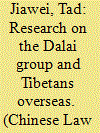

|
|
|
|
|
| Publication |
2013.
|
| Summary/Abstract |
The Dalai Lama's scheme to leave China was engineered long ago by the imperialists and Tibetan secessionists. Back in the winter of 1950, when there was a scheme for the Dalai Lama to visit Yadong County [on the border with India, tr.], "the U.S. policy was to induce him cross the Indian border . . . in the hope of persuading him to flee to the United States"1orfor him to "seek refuge" in such Buddhist countries as Burma, Thailand, or Sri Lanka. In 1956, taking advantage of the Indian government's invitation for the Dalai Lama to visit India to participate in the 2,500th anniversary of the birth of Sakyamuni, anti-China elements abroad and Tibetan secessionists collaborated in trying to get the Dalai to stay in India, and stated that "the Dalai Lama was welcome to go to the United States." After the armed insurrection in Lhasa in March, 1959, the secessionist clique succeeded in spiriting the Dalai out of China. On March 24, when they arrived at Qiongduojiang in Shannan, the head of the secessionist clique and the Dalai met with the chieftain Kampot Tashi of the "Four Rivers and Six Ranges Defenders of the Faith" and others. It was then that the Dalai andhis entourage started to maintain direct wireless communication with the U.S. Central Intelligence Agency via Wangdu, a special agent trained bythe United States.
|
|
|
|
|
|
|
|
|
|
|
|
|
|
|
|
|
|
|
|
|